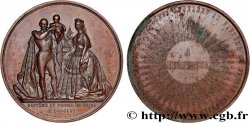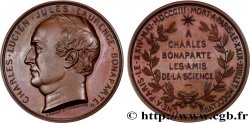fme_814246 - SECOND EMPIRE Médaille, Musée national de Picardie
100.00 €(Approx. 103.00$ | 83.00£)
Quantity
Add to your cart

Type : Médaille, Musée national de Picardie
Date: 1870
Mint name / Town : 80 - Amiens
Metal : copper
Diameter : 52 mm
Orientation dies : 12 h.
Engraver CAQUÉ Armand Auguste (1795-1881)
Weight : 60,90 g.
Edge : lisse + main CUIVRE
Puncheon : main indicatrice (1845-1860) et CUIVRE
Coments on the condition:
Patine marron hétérogène, légèrement irisée. Présence de quelques marques d’usure
Obverse
Obverse legend : IMP. NAPOLIONI. III. AVG. OPTIMO. LIB. ARTIBVM. ADIVTORI..
Obverse description : Tête nue à gauche ; signé au-dessous CAQUE F..
Reverse
Reverse legend : LEGE. LATA D. XX. M. APRIL. A. R. S. M. DCCC. LIIII // LOCVS / MVSEO. NEAPOLIONIANO / AEDIFICANDO. AP. AMBIANOS / SOCIETATI. ANTIQVAR. PICARDIAE / FELICI. MEMOIQVE / PVBLICE. DATVS.
Reverse description : Légende en six lignes, signé : MASSONET EDITEUR.
Commentary
Le musée de Picardie est un musée d'art et d'archéologie situé à Amiens, en France. Il regroupe de riches collections qui vont de la Préhistoire au XXe siècle, notamment en archéologie et en peinture. Il a reçu le label « musée de France ».
Le musée fut créé en 1802 sous le nom « musée Napoléon », en référence à l'empereur Napoléon Ier, considéré comme le « fondateur » du musée, après qu'il eut envoyé une série de tableaux à l'occasion de la signature de la paix d'Amiens.
Le bâtiment actuel du musée fut construit entre 1855 et 1867 sur les plans des architectes Henri Parent et Arthur Diet qui prirent modèle sur l'agrandissement du Palais du Louvre de Napoléon III. Véritable palais, le bâtiment a été spécifiquement conçu - ce qui, à l'époque, était une véritable innovation - pour être un musée accueillant les collections régionales d'antiquités et des œuvres d'art. C'est aussi un bâtiment à la gloire de la Picardie et à ses hommes illustres. Sur les médaillons de la façade sont sculptés les portraits d'Antoine Parmentier, Jean de La Fontaine, Robert de Luzarches… Sur le plafond peint du grand salon on peut voir Jeanne Hachette, Pierre l'Ermite, Jean Racine…
Il est l'un des premiers établissements modernes de ce type bâti en France et servit de modèle pour d'autres villes. L'édifice a été créé grâce à l'action militante de la Société des antiquaires de Picardie, soucieuse de doter la cité d'un équipement propre à accueillir les objets récoltés depuis des décennies..
Le musée fut créé en 1802 sous le nom « musée Napoléon », en référence à l'empereur Napoléon Ier, considéré comme le « fondateur » du musée, après qu'il eut envoyé une série de tableaux à l'occasion de la signature de la paix d'Amiens.
Le bâtiment actuel du musée fut construit entre 1855 et 1867 sur les plans des architectes Henri Parent et Arthur Diet qui prirent modèle sur l'agrandissement du Palais du Louvre de Napoléon III. Véritable palais, le bâtiment a été spécifiquement conçu - ce qui, à l'époque, était une véritable innovation - pour être un musée accueillant les collections régionales d'antiquités et des œuvres d'art. C'est aussi un bâtiment à la gloire de la Picardie et à ses hommes illustres. Sur les médaillons de la façade sont sculptés les portraits d'Antoine Parmentier, Jean de La Fontaine, Robert de Luzarches… Sur le plafond peint du grand salon on peut voir Jeanne Hachette, Pierre l'Ermite, Jean Racine…
Il est l'un des premiers établissements modernes de ce type bâti en France et servit de modèle pour d'autres villes. L'édifice a été créé grâce à l'action militante de la Société des antiquaires de Picardie, soucieuse de doter la cité d'un équipement propre à accueillir les objets récoltés depuis des décennies..








 Report a mistake
Report a mistake Print the page
Print the page Share my selection
Share my selection Ask a question
Ask a question Consign / sell
Consign / sell
 Full data
Full data










